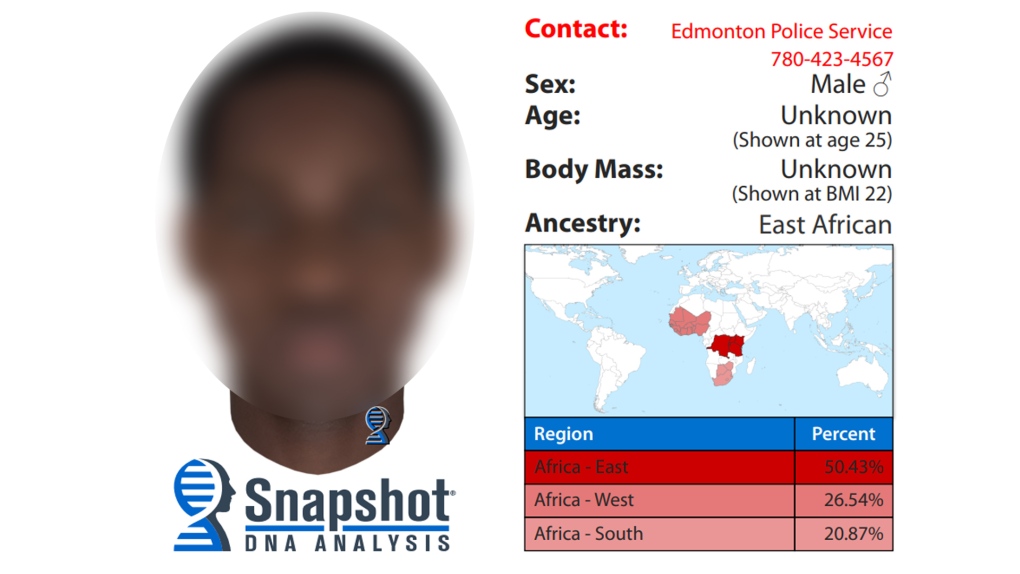EPS wants to keep using DNA phenotyping but add an oversight process
 A composite sketch of a suspect in a 2019 sex assault in Edmonton was released by police in October 2022. The image was generated by Parabon NanoLabs in Virginia and cannot predict age, body composition, or environmental and stylistic factors.
A composite sketch of a suspect in a 2019 sex assault in Edmonton was released by police in October 2022. The image was generated by Parabon NanoLabs in Virginia and cannot predict age, body composition, or environmental and stylistic factors.
Two weeks after the Edmonton Police Service apologized for releasing a generic computer-generated image of a Black man suspected of sexual assault, the service has been directed to refine it's process.
The image, created by a technology company in Virginia from the assailant’s DNA using a technique called phenotyping, was released on Oct. 4. An apology was issued two days later.
"The issue here that was created was sending a generic photo out. That's not going to happen. That's obviously put on hold…We shouldn't have done that," EPS Chief Dale McFee said Thursday.
In a unanimous vote, the Edmonton Police Commission gave EPS 30 days to come up with a community and expert oversight model to advise on how to ethically use similar technology in the future.
"We need to have something like this in place to ensure that we're looking at this for more than, say, an investigative angle," McFee told reporters after the vote.
Some feel EPS shouldn't be using the technology at all, including Haruun Ali who said the image looked like any Black man, including him.
"DNA phenotyping is not appropriate. It's not okay for us to be doing and the community doesn't want it. I don't know how more clearer we can be," said the community organizer who also regularly addresses the commission.
"Trust the community. The community knows best. We're tired of not being trusted."
A post-doctoral research fellow at Georgetown University called use of DNA phenotyping "incredibly dangerous" and a "recipe for straightforward racial profiling."
“The technology doesn’t provide useful information beyond the stereotype,” Joshua Stein told CTV News Edmonton on Tuesday.
But at least one commissioner believes that, if refined, the technology could help make Edmonton a safer city. She doesn't want to take a tool away from the police.
"These kinds of cases are often violence against women. These are often extreme rape cases where there isn't a lot of data left, there isn't a lot of room for the service to investigate," Jodi Calahoo Stonehouse said.
"And so this is about how might we see justice for sexual violence."
With files from CTV News Edmonton's Alex Antoneshyn and David Ewasuk
CTVNews.ca Top Stories

Trudeau's 2024: Did the PM become less popular this year?
Justin Trudeau’s numbers have been relatively steady this calendar year, but they've also been at their worst, according to tracking data from CTV News pollster Nik Nanos.
Back on air: John Vennavally-Rao on reclaiming his career while living with cancer
'In February, there was a time when I thought my career as a TV reporter was over,' CTV News reporter and anchor John Vennavally-Rao writes.
Death toll in attack on Christmas market in Germany rises to 5 and more than 200 injured
Germans on Saturday mourned both the victims and their shaken sense of security after a Saudi doctor intentionally drove into a Christmas market teeming with holiday shoppers, killing at least five people, including a small child, and wounding at least 200 others.
Overheated immigration system needed 'discipline' infusion: minister
An 'overheated' immigration system that admitted record numbers of newcomers to the country has harmed Canada's decades-old consensus on the benefits of immigration, Immigration Minister Marc Miller said, as he reflected on the changes in his department in a year-end interview.
Summer McIntosh makes guest appearance in 'The Nutcracker'
Summer McIntosh made a splash during her guest appearance in The National Ballet of Canada’s production of 'The Nutcracker.'
The winter solstice is here, the Northern Hemisphere's darkest day
The winter solstice is Saturday, bringing the shortest day and longest night of the year to the Northern Hemisphere — ideal conditions for holiday lights and warm blankets.
Wild boar hybrid identified near Fort Macleod, Alta.
Acting on information, an investigation by the Municipal District of Willow Creek's Agricultural Services Board (ASB) found a small population of wild boar hybrids being farmed near Fort Macleod.
Manhunt underway after woman, 23, allegedly kidnapped, found alive in river
A woman in her 20s who was possibly abducted by her ex is in hospital after the car she was in plunged into the Richelieu River.
Poilievre writes to GG calling for House recall, confidence vote after Singh declares he's ready to bring Liberals down
Conservative Leader Pierre Poilievre has written to Gov. Gen. Mary Simon, imploring her to 'use your authority to inform the prime minister that he must' recall the House of Commons so a non-confidence vote can be held. This move comes in light of NDP Leader Jagmeet Singh publishing a letter stating his caucus 'will vote to bring this government down' sometime in 2025.

































